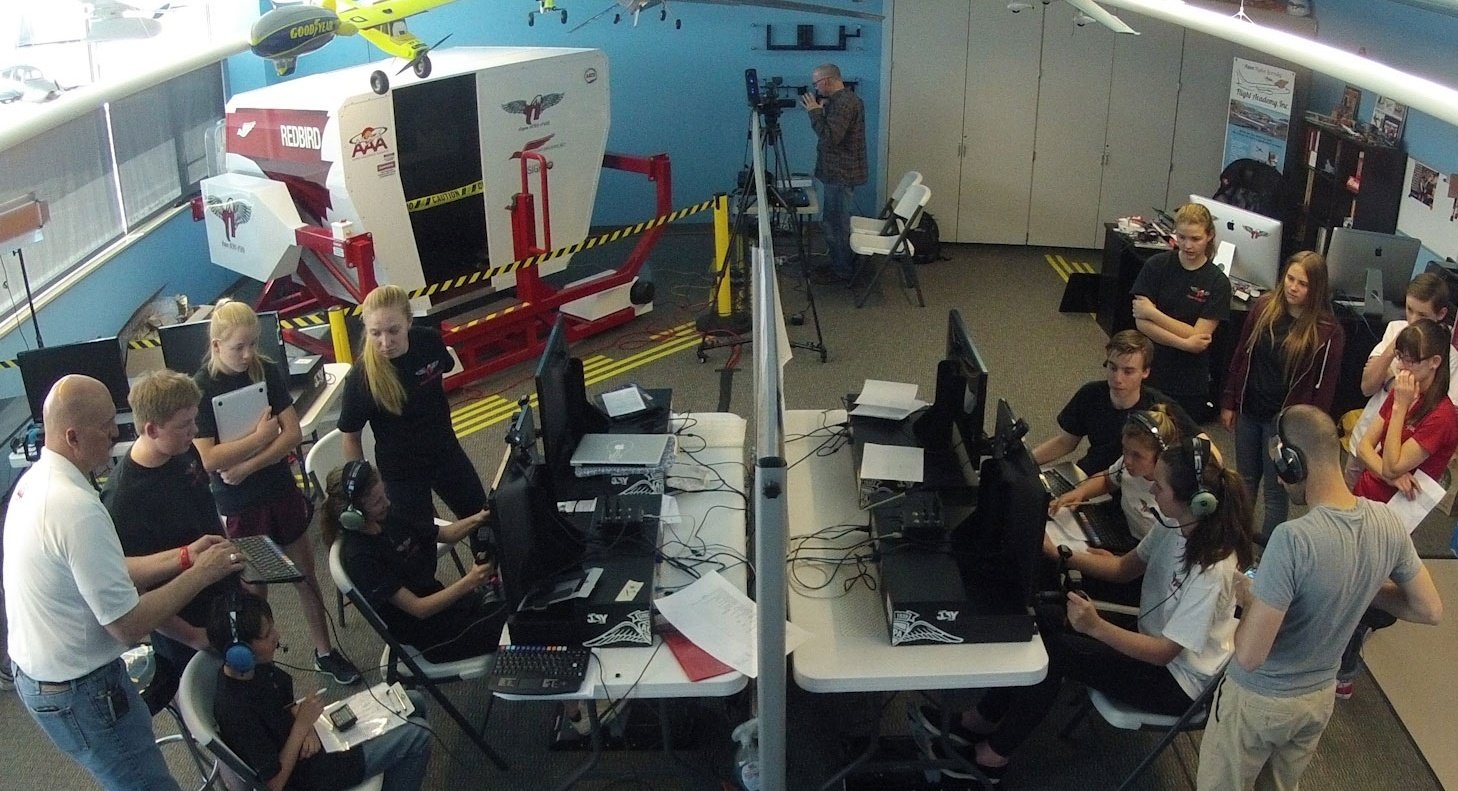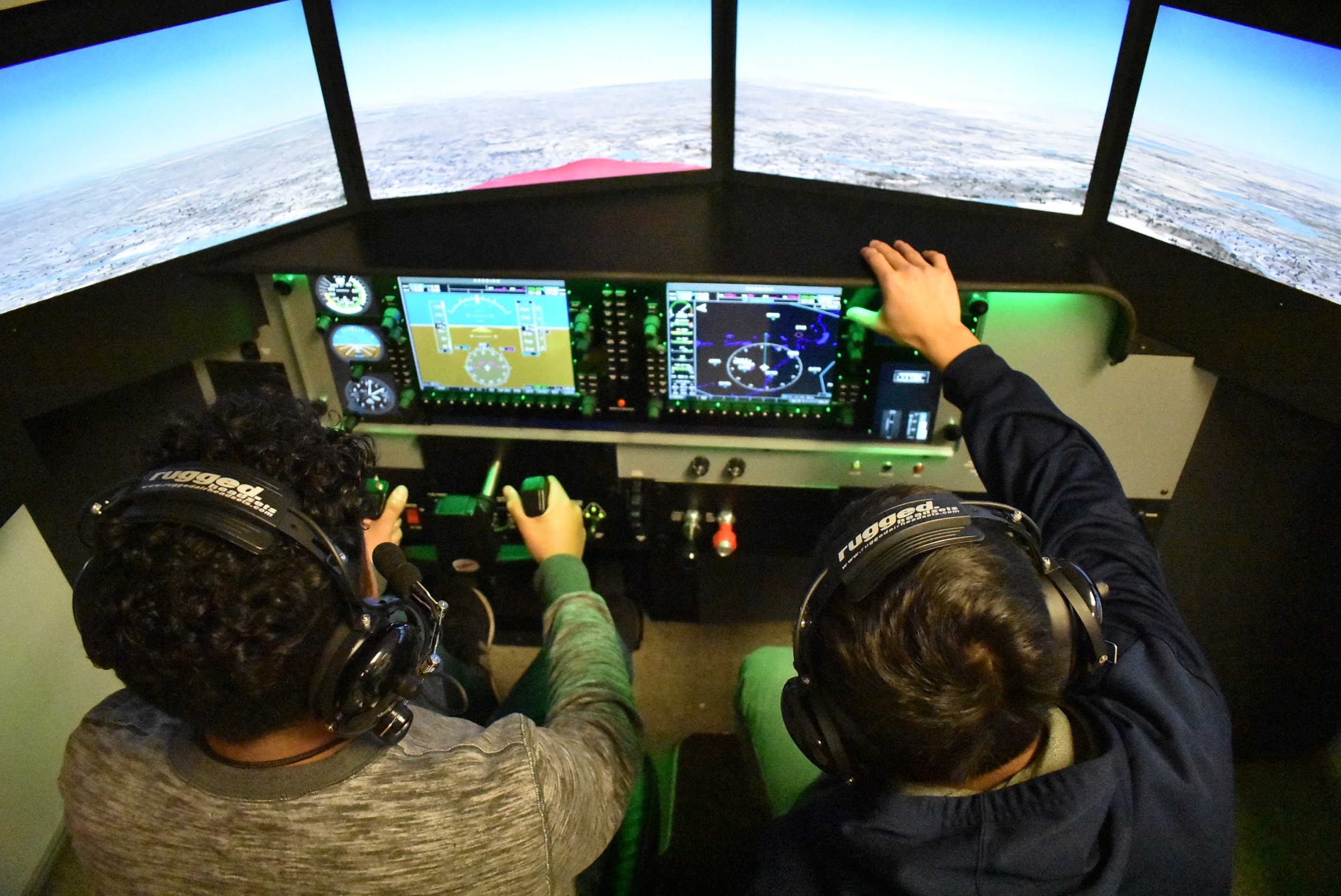How Redbird Courseware Helps High School Students Learn To Fly
Redbird Flight offers multiple courseware options, Guided Independent Flight Training (GIFT) and Simulated Flight School, that enhance learning in and out of the classroom. The courseware is compatible with any of the company’s all-in-one flight simulators running its operating system, Navigator.
Both solutions provide K-12 teachers who are new to aviation — or who want help keeping students on task and on track while operating flight simulators in the classroom — turnkey interactive lesson supplements and individualized scoring and progress tracking for every student. In this article, I will discuss both solutions, their differences, and how they helped my students achieve their goals in the classroom and gain an advantage when they pursued their pilot certificates.
Redbird GIFT
Redbird offers two versions of GIFT, one for private pilot training and another for instrument training. I will focus on GIFT Private Pilot in this article, as it is more commonly used in high schools.
The private pilot version includes 33 standalone missions that teach all the maneuvers in the Private Pilot Airman Certification Standards (ACS).
GIFT Private Pilot missions
- Introduction Flight
- Straight and Level Flight
- Changing Airspeed in Straight and Level Flight
- Normal Turns
- Normal Climb
- Best Rate of Climb
- Best Angle of Climb
- Descent
- Steep Turns
- Taxi
- Normal Takeoff
- Crosswind Takeoff
- Slow Flight
- Rectangular Course
- Turns Around a Point
- S-Turns
- Power Off (Landing) Stall
- Power On (Takeoff) Stall
- Basic Instrument Flight
- Normal Landing
- Crosswind Landing
- Traffic Pattern Operations
- Go Around
- Rejected Takeoff
- Emergency Approach and Landing
- Short Field Takeoff
- Short Field Landing
- Soft Field Takeoff
- Soft Field Landing
- Lost Procedures
- Instrument Climb, Descent, Turns to a Heading
- Cross Country 1 (Short)
- Cross Country 2 (Long)
Since GIFT requires students to follow precise guidelines to complete each mission to ACS standards, teachers can allow students to fly the missions independently. For example, in the "Normal Landing" mission, students are set on a final approach course in straight and level flight. They are presented with green boxes, called gates, on the screen through which to fly.
The courseware prompts students to reduce the throttle and add ten degrees of flaps. Through each subsequent gate on the descent, GIFT prompts students to add flaps and reduce their airspeed accordingly.
An AI-based flight instructor keeps a tight watch on the airspeed, altitude, and flap settings as students descend to the runway, providing audible corrections as necessary. A touchdown zone is highlighted on the runway to make it easy for students to see.
After landing and applying brakes, the mission is over. Students are then taken to the analysis screen, where they see whether or not they met the ACS standards. Each mission builds upon the prior knowledge gained in previous missions.
A GIFT license costs $249 and is intended for use by a single student. With individual licenses, students can track their progress over time.
Once you purchase a license for a student, it is mapped to a USB key and the student’s account online. With an active internet connection, you can upload the flight records from the USB key to the Redbird server. Therefore, if the student loses or damages the USB key, s/he may download the GIFT registration onto another formatted USB. The student’s flight records will still be up to date.
Let's say a student can access a Redbird flight simulator elsewhere (at home, in a local flight school, etc.). Once the student leaves the classroom, the license can stay with the student on the USB key. S/he can go to another Redbird flight simulator, insert the USB, and continue using GIFT from where s/he left off.
Students can use GIFT without a USB by logging in directly on a Redbird flight simulator. Additionally, they can access the GIFT pre- and post-flight briefings and videos from home by logging into the GIFT website with their Redbird account information.
Redbird Simulated Flight School
Simulated Flight School enters the picture when a high school wants to offer a complete private pilot course with a learning management system (LMS) featuring intuitive views for student tracking and comprehensive analysis of student performance.
The course mimics what a student would learn during ab initio flight training, utilizing video instruction and flight simulation to bring it into the classroom environment.
Simulated Flight School lives entirely online. Students log in, set their password, and then they can access the content anywhere with an internet connection. Unlike the standalone GIFT product, Simulated Flight School allows teachers to see each student’s progress and areas for improvement from the LMS.
How it works
Let’s say a high school student, Mike, is practicing S-turns using Redbird Simulated Flight School. At home, he watched the video and read the accompanying text explaining how to do the maneuver.
The next day, he gets onto the Redbird flight simulator at school, logs in, and begins the S-turns mission with zero wind. According to the ACS, he is allowed +/- 100 feet altitude deviation and an airspeed deviation of +/- 10 knots.
After correctly completing the first 180-degree turn, Mike begins the next 180-degree turn to complete the "S.” This time, Mike's bank angle is very steep, and as a result, he drops below the assigned altitude by 150 feet, and his airspeed increases by 13 knots.
The AI-based flight instructor reminds Mike to correct his altitude and airspeed. As Mike shallows the bank and gently increases back pressure to climb to his original altitude, his airspeed drops back down close to the target airspeed. Due to the increased rate of turn, Mike is unable to finish the maneuver with his wings parallel to the road.
The scoring shows that Mike did not meet the ACS, pointing out his highest, lowest, and average altitude and airspeed compared to the targets to meet ACS standards. It includes an overhead view of the maneuver with the actual flight path across the road and back. It is very easy to see that the second turn was too steep.
Mike’s teacher logs into the LMS to check which students completed the lesson successfully. He clicks on Mike's name and sees the same scoring and evaluation as Mike. In this instance, the teacher knows by the overhead view of the flight path that the steep turn occurred in the second half of the maneuver.
Therefore, the teacher would be able to provide specific guidance to Mike.
- The first half of the S-turn was great.
- The second half was too steep because the bank angle increased past 30 degrees, dropping the nose.
- That resulted in greater wing loading and raised the stall speed.
- On a second attempt at the mission, adding more back pressure and reducing the bank angle will provide more vertical lift.
This is an example where the student tried a maneuver and was unsuccessful at first. Additional instruction was given with explanations. The student then could go on to try the maneuver again and complete it successfully.
The Bottom Line
As a teacher and flight instructor, I can say that Redbird’s products greatly speed up training once a student reaches the airplane. Most of the time is spent polishing the maneuvers rather than learning them from scratch.
I have had numerous students complete the GIFT course. Once they get into a real airplane for the first time, they are amazing! They already know how to taxi, take off, climb, level off, trim, bank, descend, approach, and (mostly) land the airplane.
Other flight instructors at our local flight school have also attested to the fact that the most proficient and knowledgeable first-time students are the ones who learned with GIFT.
However, if you implement GIFT or Simulated Flight School into the classroom, do not allow the courseware to serve as a stand-in for classroom instruction. I recommend imparting additional details about why and when students would perform a given maneuver. When students understand why they are performing a maneuver and how it applies to real-world flying, they are more likely to have success long after learning it.
If you are interested in either GIFT or Simulated Flight School, call Redbird and ask them about getting set up. You will be glad you did.
Share this
You May Also Like
These Related Articles

Starting a High School Aviation Program Without Breaking the Bank

The Impressive Story of 24 Students that "Flew" Around the World




